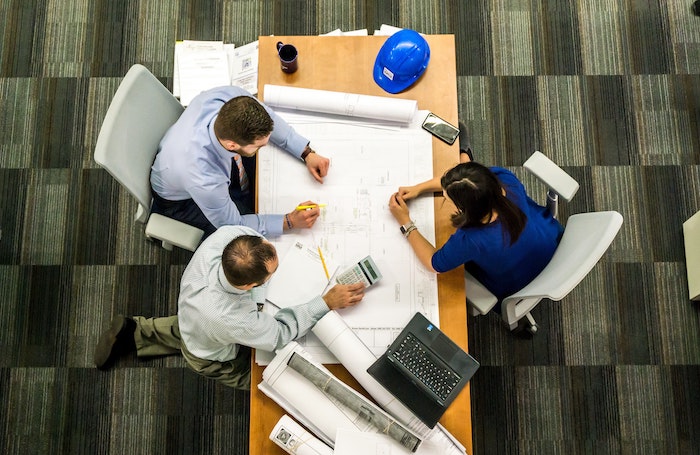Construction workloads have always been cyclical, and according to the latest RIBA Future Trends Workload Index, architects’ confidence levels are currently at their lowest point, barring lockdown, since the 2009 recession. Consequently, some practices may begin to wonder if their workload will stay strong in the medium term, especially if they work on smaller domestic projects.
Mark Kemp, Director of PLACE architects and author of the new and timely RIBA Good Practice Guide on Business Resilience, argues that keeping your practice in good shape for the next downturn should be seen as an essential part of running an architectural business.
Revisiting your business plan
To begin, Mark suggests reviewing what you do well as a practice and revisiting core values and principles in your business plan.
Mark’s own practice is doing this right now.
Revisiting a business plan can provide clarity and reaffirmation, but also provides an opportunity to reassess if your strategy needs adapting to a changing business environment.
“Your business plan must be flexible enough to withstand being blown off course temporarily before you have a chance to navigate back to where you need to be – which is heading towards your vision,” Marks says.
“Revisiting the business plan doesn’t mean you need to change it. The exercise can act as a way to reinforce values and re-examine what a practice is doing and why it is doing it. It’s also a chance for staff members to ask themselves if they still believe in their practice’s values.”

Projecting confidence with clients
When downturns and changes in markets do occur – things many have seen before – businesses have to project confidence.
One of the ways to do this, Mark argues, is to make sure there’s an open line of communication between the practice and current clients. In fact, as tough times bite hard, he recommends contacting clients more regularly – even when an architect is waiting for the next stage of a project to proceed.
“Gaps are a natural part of the design and construction process but keeping in touch with clients - even if it is just to tell them that nothing has happened since you last spoke - keeps the lines of communication open,” he says.
“Keeping in more regular contact may also flush out clients who are starting to waver and gives architects an early warning sign that they might not wish to proceed further with a project. This is valuable to know in itself and can prevent time being wasted.”
Targeting areas and groups for new projects
Downturns may also present an opportunity to treat any spare time as a way to look at the potential for diversification. Mark says that considering if a practice could promote a new service may open up new areas of business.
“Find where the money is,” he suggests. “Look at areas where people are more likely to be spending.”
Local recent retirees, people who have relocated and are now working from home, and people looking to reduce energy bills through retrofitting and insulation are all potential sources of new business in the current climate.
The temptation during a downturn is to cut down on advertising but Mark argues it’s the right time to spend more or look at new ways of letting a local community know what services you offer. This could mean reinforcing your expertise in a particular area - such as gaining planning permission or low-carbon extensions – as well as any new areas you think are ripe for exploration.
“Also consider areas that might be doing well in the property markets. Perhaps you can start a Facebook campaign that targets these sectors,” he adds.
Small practices can also encourage staff to get involved in local clubs, community groups, and local campaigning groups – there is always a chance that someone might need architectural services.
Consider upskilling non-architectural staff
Mark also recommends making the most of any spare time to upskill non-architectural staff. While architects naturally undertake regular CPD and add-in training on CAD, he argues that non-architectural staff should not be overlooked and finds that there is significant value in including them in CPD of all types. This could range from in-house learning from, for instance, a local contamination or ecology expert, to attending formal RIBA CPD seminars or events.
This can provide a broader depth of understanding for non-architectural staff into the world of architecture in which they find themselves working.
Mark also recommends that non-architectural staff also brush up on basic software like MS Excel, Word, InDesign, or Photoshop. Learning new skills, or reinforcing them, for all staff can bring benefits to a business and could lead to an increase in productivity percentages.
Good Practice Guide: Business Resilience is a how-to guide for building business resilience into your architectural practice, offering methods for managing business-critical events.
Use this link to purchase the book with a special 20% discount (valid until 31 December 2022).
RIBA is delivering relevant content and resources around business resilience that can be applied to your practice and in your career, available on our business and career resilience hub.
Thanks to Mark Kemp, Director, PLACE architects.
Text by Neal Morris. This is a Professional Feature edited by the RIBA Practice team. Send us your feedback and ideas.
RIBA Core Curriculum topic: Business, clients and services.
As part of the flexible RIBA CPD programme, professional features count as microlearning. See further information on the updated RIBA CPD core curriculum and on fulfilling your CPD requirements as a RIBA Chartered Member.









